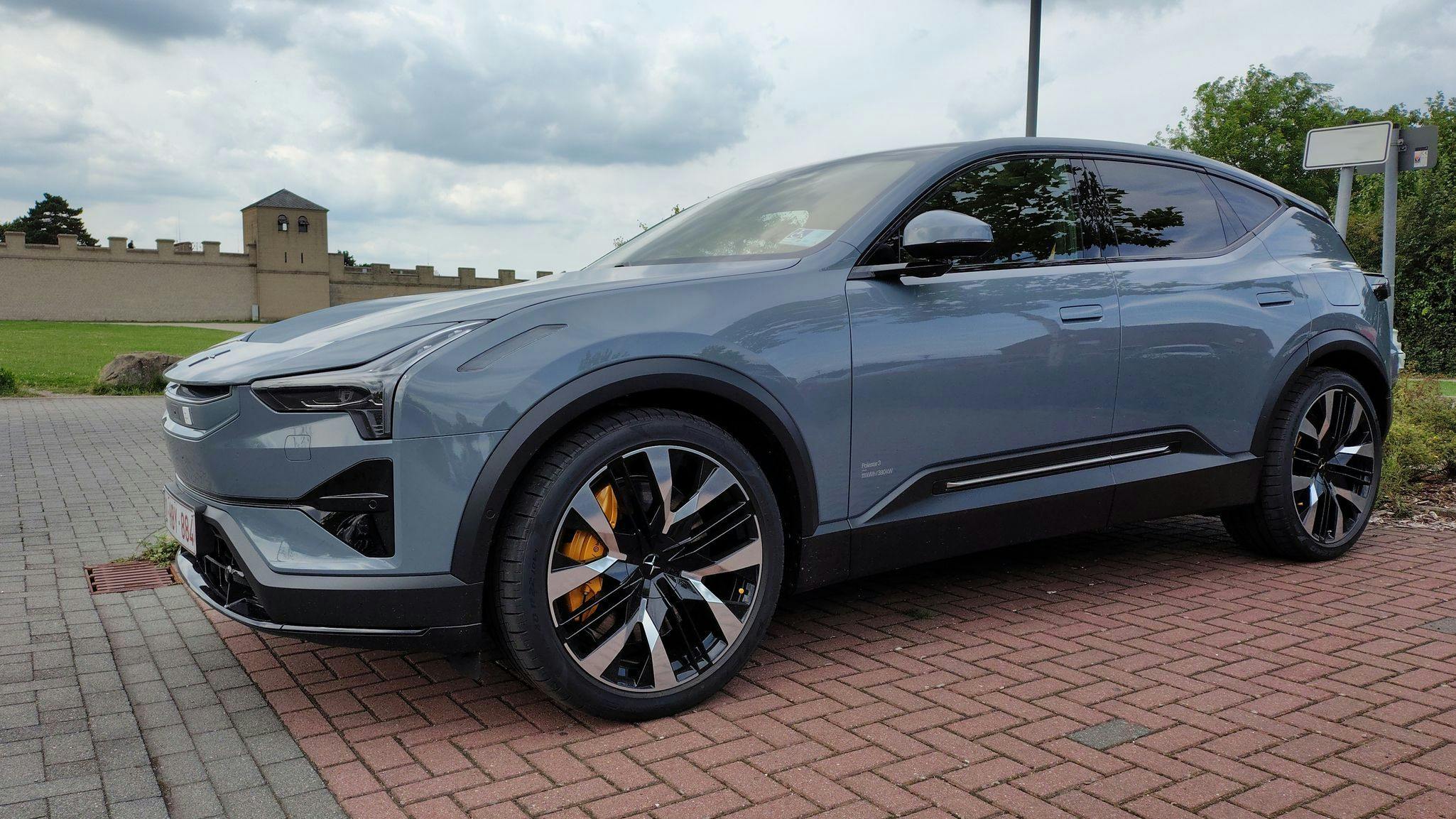
TAGTIK NEWS - TO THE POINT
Polestar 3: dynamic excursion with a thirst for range

Technically, the Polestar 3 and the Volvo EX90 are very similar. However, the Chinese-Swedish car is a little shorter and, above all, lower. It's better cut from an aerodynamic point of view. A plus for the range?

With the 300 kW Volvo EX90, I went to Aveyron, France. This time, with the Polestar 3 Dual Motor Performance, we headed to the banks of the Rhine. With 380 kW, or 517 hp, the German Autobahn is waiting for me. Especially since the car promises a great range. Officially, this SUV with a stretched roof reaches 567km according to the WLTP standard. There are other Polestar 3 solutions that are even more generous with 107 kWh of usable battery. The most "economical" 220 kW version promises 706 km in WLTP! But let's get back to the car in our hands. This Performance version is the "meanest" with a 0 to 100km/h in 4.7 s and a top speed of 210km/h. All this while measuring 4.90m...

First Kilometers
Discovering the cockpit is relentlessly reminiscent of the Volvo EX90. I'm therefore on familiar ground. There are few differences at first glance. There's the P-R-N-D selector lever that also activates the cruise control. There's also the large 14.5-inch vertical central screen. No Android Auto, but Android Automotive linked to a private Gmail account (Google Workspaces requires actions from the professional account administrator). Lucky iPhone owners, who can pair their car with their private and/or professional world to access all their apps (WhatsApp among others). On the Polestar's steering wheel, the touch buttons are all black. No small logo or light to indicate the function of the 12 available zones.

The space between the seats is almost similar to the Volvo with the induction charger... Why am I talking about this charger? Because of the key. I was lucky enough to get behind the wheel of a very recent model with very few kilometers. "The key battery still needs to be charged," I was warned. In short, instead of my smartphone, I will have to place this key in it so that it can recharge. In the meantime, no remote (un)locking. You have to place the key near the retractable handle to get in. Then you have to place it on the inductor to start. No question of leaving it in your pocket. Fine! In a few kilometers, this will be solved, I thought. Well, no, not even after 500km!

I won't tell you how much of a hassle it is to open the trunk with your arms full of groceries by first unlocking the car by placing the parallelepiped on the driver's side. Because opening the electric tailgate by putting your foot under the bumper is a pain. And since the remote control still isn't charged enough, even the vehicle's locking button after closing the trunk remains inactive. You have to go back to the handle to lock the vehicle. Otherwise, there's a digital key option via the Polestar app on your smartphone. But I didn't have that convenience for the test. Honestly, I don't think the problem is the battery, but rather the key settings... To change them, you have to be the owner of the vehicle, etc.

Same problems
Like its Volvo cousin, the Polestar 3 has a truncated cruise control system. There's no way to retrieve the recorded speed by pressing any "Resume" button. You must first deactivate cruise control via the gear selector, then reactivate it with the same selector. And if necessary, set the desired maximum speed using the left-hand buttons on the steering wheel. But at least it didn't fail during the test drive, as the Volvo did during our trip to the south. The same goes for the ADAS (advanced driving assistance systems), which remained faithful throughout the entire test with the Polestar. Oddly, the 3 doesn't allow you to adjust the audio volume with the driving wheel. You have to do it using the dial on the console.

What's my point? Of the twelve touchscreens on the steering wheel, very few are actually useful. Some are also used to adjust the mirrors. And I haven't figured out how to configure and customize them. Let's hope that, with time and over-the-air updates (I got one that didn't add much), the 3 will eventually become more ergonomic. Oh yeah! Here too, the rear fog light only turns on via on-screen controls. Stupid and dangerous.

Otherwise, it's fine.
Beyond these anomalies, the experience behind the wheel of the Polestar 3 was generally satisfactory. This large car really has a lot of character when accelerating. The dense traffic on a stretch of unrestricted traffic in Germany didn't allow us to reach the top speed. 190km/h at most (which is already quite good). Pick-up after slowing down is lively.

Like a gentleman, cruising on the Autobahn at 160km/h is easy and comfortable. The chassis places the vehicle firmly on its wheels to ensure good stability, even when cornering. All this with the occasional very slight aerodynamic whistle. So, cruising on the motorway at 100, 110, 120, 130km/h or more is possible without waking the sleepers on board. For the driver, the head-up display and the small instrument panel behind the steering wheel allow them to monitor their progress.

On country road bends, the machine remains precise thanks to torque vectoring, which uses the rear-wheel drive to distribute torque and power between the two wheels. Body roll is controlled, thanks to the adaptive suspension and the battery under the floor. The steering firms up if necessary, but remains somewhat artificial. This is hardly a handicap. For its part, braking is effective, without being exceptional. 2.6 tons is no small feat! I opted for the Low regeneration mode, pressing the shortcut on the screen, with a little inertia, just to maintain control over slowdowns. In the city, despite its size, the Polestar 3 remains maneuverable. Even if we praise the inventor of cameras for gauging the bodywork in parking lots and narrow streets. And for spotting the marking on the ground to signal its presence at "intelligent" traffic lights.

Spacious vessel
13cm shorter than the Volvo, which means no third row of seats. The Polestar 3 is therefore a 5-seater. It's even generously sized to accommodate rear passengers. Comfort is truly regal. The finish is particularly meticulous in a no-frills design. There are real storage compartments and well-designed storage areas. However, to open the glove compartment, you have to use (once again) the touchscreen!

The trunk offers "only" 484 liters under the luggage cover. But the space under its floor can be put to an original use: hooks on its lid allow you to hold three shopping bags. When folded down, the volume can reach 1,411 liters.

To avoid wasting space with cables in this luggage compartment, the 32-litre frunk is perfect for the job. You can also leave a fire extinguisher, a bag, and a few other odds and ends there. Behind the windshield, a small hook allows you to store, for example, your PMR card, blue zone disc, or parking ticket.

And the range?
To test the range, I chose the Roman Archaeological Park of Xanten, Germany, as my destination. It's a Roman fortified city under reconstruction. Getting there involves a motorway journey of over 200km, including a trip through the Netherlands. Even with 75% battery capacity, the trip can be completed without charging before reaching the destination. However, we took advantage of a break to recharge the battery before the border. Especially since at a brisk pace on the German motorway, consumption can exceed 35 kWh/100km. In reality, the unrestricted sections are often interspersed with restricted areas. Therefore, our test average was 28 kWh/100km for this direct route.

On the Belgian motorway, at 120km/h, we drop back to 25 kWh/100km with mild temperatures. That's a maximum range of 400km! Basically, we can drive 3 hours without any problems between charging stations. Not bad for a car vacation. In winter, in very cold weather, 300km relays are possible. The maximum charging speed is 250 kW. The battery regains strength up to 80% in 30 minutes. But at home, with 11 kW, it takes a lot longer (11 hours 30 minutes). In the city, at 30km/h and 50km/h, our Polestar 3 had a consumption of around 16.5 kWh/100km. On average, over 800km over 7 days, our energy requirement was 23.6 kWh/100km with a lot of motorway. This confirms a truly great range (450km on average), despite rather high consumption outside built-up areas, despite the aerodynamic features, including the bar on the hood. Thanks to the 111 kWh gross!

Budget
On a fast charging station at €0.73/kWh, 100km on the motorway at 25 kWh/100km ends up costing €18.25. That's not even cheaper than diesel. Fortunately, there are cheaper charging stations. When traveling, you'll need to remember to regularly plug into slow or semi-fast charging stations during long breaks (restaurants, sightseeing, hotels) to achieve more economical mileage costs. In any case, you should have enough time to charge overnight.

In Belgium, the 220 kW (300 hp) Polestar 3 with an official range of 706km starts at €78,500 (excluding promotions). For the 380 kW (517 hp) Polestar 3 Performance model tested here (567 km WLTP), the bill rises to €92,100. But with the options installed in the model shown, including the excellent Bowers & Wilkins audio system (€6,000 in addition to the €2,800 Pilot pack) and the Megapixel LED headlights, you'll have to pay at least €103,800. Note that Polestar recommends ordering online with delivery. Although it's still possible to discover its models in one of its "Spaces," exhibition spaces.

In the Grand Duchy of Luxembourg, prices start at €75,850 (220 kW) and go up to €89,000 (380 kW). In the configuration of this road test, you'll have to pay €99,850. In France, Polestar is a recent arrival. The Polestar 3 starts at €79,800 (excluding promotions). The Performance variant of our test costs €91,800. Adding the accessories from our test drive will bring the price to €102,500. In the Swiss market, prices start at CHF 78,800 (excluding discounts). For the Polestar 3 Performance, you'll have to pay at least CHF 92,800. Equipped like our test drive, it's CHF 104,250.

In the Netherlands, the price range is from €79,950 (220 kW) to €93,550 (380 kW). Configured as for this test, the Polestar 3 Performance costs €104,950. For reference, the 380 kW Polestar 3 Performance (basic equipment) costs at least €92,190 in Germany and £81,500 in the UK.

(MH with Olivier Duquesne – Source : Polestar – Photos : © Olivier Duquesne)

LATEST NEWS

Born on December 6: Ben Watt, the male half of Everything But The Girl

Born on December 5: Patricia Kaas, The Voice's (France) new coach

Jafar Panahi Wins New York Award and is Sentenced to Prison by Iran

Born on December 2: Peter Kingsbery, founder of Cock Robin with firebrand Ana LaCazio

Born on December 1: Julee Cruise, "Twin Peaks'" haunting voice

Born on December 1st: Alain Bashung, French rock poet who waited a long time for success
Quick links